| Volvo B8L | |
 |
|
| Manufacturer | Volvo Buses |
| Bodywork | Wright Gemini 3 |
| Years in operation | 2017–2020; 2022 – |
| Operator | A&S Transit (2022–) |
| Former Operator | SBS Transit (2017–2020) |
| Technical Data | |
| Length | 12 metre |
| Engine | Volvo D8K350 EU6 |
| Transmission | ZF EcoLife 6 AP 1400 C |
| Accessibility | Low Floor |
| Emission Standard | Euro VI (EGR + SCR) |
The Volvo B8L is a low-floor, 3-axle bus chassis built by Volvo Buses, as the intended successor to the Volvo B9TL chassis still currently in production.
The model was formally launched in January 2018; with two known pre-production units manufactured. One unit was trialled in Hong Kong with Kowloon Motor Bus (fleet code AVBWL1), and the other unit was trialled in Singapore with SBS Transit, registered SG4003D.
SBS Transit’s Volvo B8L entered revenue service on 2 April 2018, operating on Bus Service 94, and subsequently redeployed to Bus Service 71 from 9 July 2018 until April 2020. The bus was last spotted on revenue service in April 2020, and thereafter returned to Volvo Buses, concluding its trial period on Singapore roads. SG4003D was placed on non-user lay-up status from 27 June 2020.
In June 2022, the bus was transferred to private operator A&S Transit and re-registered as PD169L.
History:
The Volvo B8L was conceived as the Euro VI (or Euro 6) successor to the highly popular tri-axle Volvo B9TL which had been in production since 2002, an evolutionary step in line with more rigorous emission standards across the world, and targeted at the Asia Pacific markets of Hong Kong and Singapore. The B8L model designation indicates its (Bus chassis, 8-litre engine, Low floor) configuration.
Volvo’s new range of Euro VI-compliant diesel engines, the 5.1-litre Volvo D5K and 7.7-litre Volvo D8K, were launched in 2013 and found their way into new bus models, such as the Volvo B5TL (diesel) and Volvo B5LH (diesel-hybrid) double-deck city buses, and the Volvo B8R (coach) and Volvo B8RLE (low-entry) single deck buses. Volvo Buses would subsequently release more models of buses would to further strengthen their model offering in line with the Euro VI adoption.
However, in Asia (and particularly Singapore and Hong Kong), demand for the tri-axle Volvo B9TL remained strong where Euro VI emissions regulations (or their equivalents) had yet to take effect. In preparation for eventual Euro VI adoption, the Volvo B8L chassis was developed as a replacement for the tri-axle Volvo B9TL which was only offered up to Euro V emissions standards. Production of Volvo B9TL has yet to officially cease.
The Volvo B8L was formally launched on 25 January 2018 at a media event in Hong Kong (although a pre-production demonstrator unit was trialled with Kowloon Motor Bus since May 2017) and produced in lengths up to 13.4 metres. A Euro VI-compliant Volvo D8K engine is offered with 280, 320 and 350-horsepower options. Transmission offerings have so far only included ZF units. The Volvo B8L is reportedly 600kg lighter like-for-like than the B9TL, that when combined with an offset, in-line engine, gives a fuel efficiency gain of 10%.
Design
One key design change in the Volvo B8L is the longitudinally-mounted engine and the use of the middle axle as the drive axle. This improved the traction and handling characteristics of the bus, while also accommodating rear-axle steering on these buses, depending on customer requirements. In contrast, the Volvo B9TL had a transverse-mounted engine and the rear axle as the drive axle.
With this new in-line engine, Volvo has finally deviated from its long-time layout of incorporating a transverse engine with angle drive. It originated with Leyland Atlantean, and continued with the Leyland and then Volvo Olympian and finally to the B9TL which remains in production. The simplified in-line drivetrain, coupled with the high efficiency of the Euro VI diesel engine, offers lower emissions and longer service intervals.
The Volvo B8L has also positioned its diesel and AdBlue tanks on the right side of the bus. The engine incorporates Exhaust Gas Recirculation (EGR) with Selective Catalytic Reduction (SCR) to manage emissions levels in line with the Euro VI standard for heavy vehicles.
The B8L is also known to be compatible with the Wright Eclipse Gemini bodywork range produced by Wrightbus. For the pre-production units, the Hong Kong unit (fleet code AVBWL1) was bodied with the Wright Eclipse Gemini 2 bodywork, and the Singapore unit (SG4003D) was bodied with the newer, third-generation Gemini 3 bodywork.
Operators
Franchised bus operators in Hong Kong have made batch orders for the Volvo B8L, namely Kowloon Motor Bus, Long Win Bus, Citybus and New World First Bus, all of whom procured them with the Wright Gemini 3 bodywork.
In addition, the MCV Evoseti bodywork has been fitted to the Volvo B8L, with Kowloon Motor Bus taking in 2 prototype buses (12 m length) in 2018/2019, followed up by production batch orders (12.8 m length) in 2020. In Malaysia, Gemilang-bodied Volvo B8Ls were procured by Rapid Bus Sdn Bhd, and entered service in the Kuala Lumpur / Klang Valley region in June 2020.
In November 2018, Alexander Dennis offered the 13.4-metre Enviro400 XLB with the Volvo B8L chassis. In the United Kingdom market, units acquired by Lothian Buses in Edinburgh entered service in early 2019, and Cambridgeshire Guided Busway units entered service in early 2020.
SBS Transit Volvo B8L (SG4003D):
The first Volvo B8L in Singapore was one of two known pre-production units, intended for road trials ahead of mass production. The other pre-production unit entered service with Hong Kong bus operator Kowloon Motor Bus in 2017.
The Singapore unit (chassis number YV3U2U529HA184195) is bodied with the Wright Gemini 3 bodywork, and was first registered on 15 December 2017 as SG4003D. It was also the first time that the Wright Gemini 3 bodywork was fitted to a three-axle bus.
The bus was first exhibited at the Seletar Bus Depot Carnival held on 27 January 2018. It entered revenue service on 2 April 2018, operating on Bus Service 94, and subsequently redeployed to Bus Service 71 from 9 July 2018 until April 2020. The bus was returned to Volvo Buses after two years on the road.
| Basic Technical Specifications | |
| Engine | Volvo D8K350 EU6, 7698cc Power/torque rating of 258 kW @ 2100 rpm / 1400 Nm @ 1200 – 1600 rpm |
| Emissions control | Euro VI-compliant Engine combines Exhaust Gas Recirculation (EGR) with Selective Catalytic Reduction (SCR), hence requiring diesel exhaust fluids such as AdBlue |
| Transmission | ZF EcoLife 6 AP 1400 C gearbox Six-speed automated transmission |
| Bodywork | Wright Gemini 3 Bodywork Assembled by Wrightbus in Northern Ireland, shipped completely-built-up (CBU) to Singapore |
| Passenger Capacity | 55 Upper Deck Seating + 29 Lower Deck Seating + 53 Standing = 137 total |
| Other features | LECIP Electronic Destination Sign (EDS), Orange LED Matrix SMC Transit doors (leaf entrance doors, outward-swinging exit plug doors) Denso air-conditioning Mobileye Shield+ Collision Avoidance System Volvo Bus I-Coaching USB Charging Ports at selected seats Removed: SMC Transit automatic wheelchair ramp (operated from driver’s cab) |
SG4003D was formerly equipped with an automatic wheelchair ramp supplied by SMC Transit, and was featured at the Seletar Bus Depot Carnival. However, it was replaced by a manual wheelchair ramp prior to entering revenue service.
SG4003D also made an appearance at the Ulu Pandan Bus Depot Carnival held on 27 October 2018.
Hong Kong unit
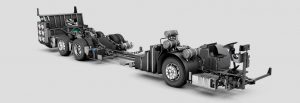
The other pre-production Volvo B8L entered service with Hong Kong bus operator Kowloon Motor Bus in 2017, registered UU8290 (fleet code AVBWL1) and bodied with the Wright Eclipse Gemini 2 bodywork. It is fitted with a Volvo D8K350 paired with a ZF EcoLife 6 AP 1600 BS transmission.
According to the HK Bus Fandom page, the front axle featured narrower tyres (275/70R 22.5) as compared to tyres on the other axles (305/70R 22.5). In contrast, SG4003D and future Volvo B8L production units were solely fitted with 305/70R 22.5 tyres. The bus was launched at a ceremony on 11 May 2017, branded as Hong Kong’s first Euro 6 pure diesel-powered bus. The bus made its revenue service debut on Bus Service 968 on 25 May 2017.
A&S Transit Volvo B8L (PD169L):
In June 2022, the bus was subsequently re-registered to private bus operator A&S Transit as PD169L. It is branded as “People Mover Deluxe”, and was launched in a ceremony held at Marina Centre by A&S on 3 July 2022.
The livery art on the bus was created by A&S General Manager Dexter Ang.
As part of the modifications, lap belts were added to every seat in the bus.
Exterior
The external appearance of the bus was adapted from the Gemini 3 bodywork produced by Wrightbus. Previously fitted to two-axle double-deck buses such as the Volvo B5TL and Volvo B5LH, SG4003D was the first time that the Gemini 3 bodywork has been fitted to a three-axle double-deck bus.
The Volvo B8L was also the first public bus in Singapore to bear the Gemini 3 bodywork and was easily recognisable from its distinctive exterior features. It was also the first time that the ‘glass staircase’ was introduced to Singapore buses, with glass panels running the length of the stairs.
Interior:
Lower Deck
The lower deck of the bus featured 20 permanent seats. Being a low-floor bus, the bus offered step-free access from entry/exit doors until the last row of seats. A staircase behind the driver’s cab connects the lower and upper decks.
Like most double-deck buses in Singapore, the Volvo B8L bus was configured with two doors: an entrance door at the front, and an exit door in the middle. The entrance doors were conventional inward-swinging leaf doors, while the exit doors were outward-swinging plug doors. These pneumatically operated doors were supplied by SMC Transit.
Seats were supplied by Vogel Industries of Malaysia (Model: System 750/3) in yellow, with priority seats in red. The seat upholstery was made of fabric material (likely polyester), unlike newer buses in Singapore which opt for PVC covers, which are more durable.
Opposite the staircase, there are four side-facing priority seats, reserved for elderly and handicapped passengers, and passengers travelling with young children. They were indicated in red seat covers.
The wheelchair bay behind the staircase and opposite the exit door accommodated one passenger-in-wheelchair (PIW), and was also equipped with a USB Charging port. Two straps with buckles were also installed as part of a restraint system for wheelchairs or prams; a separate stroller restraint system was trialled months prior to the launch of these buses.
Grab poles and hand grips were located on both sides of the aisle. All seats also had hand grips to provide commuters with additional support.
Bus stopping bell-pushes were located around the bus cabin, mounted to stanchion poles. Emergency hammers were located on the bus pillars.
The seating layout at the rear was similar to the MAN A95 and the Alexander Dennis Enviro500 buses, with facing seats in-between wheel arches and more facing seats at the last row of the bus, which seats 5 passengers across.
The seats on SG4003D came in two colour tones: red and yellow. Both colour tones came with beige trim on the outer edges. This colour scheme was similar to SBS Transit’s original specifications for its Volvo B9TL buses, but applied in the reverse, with red seat covers for priority seats, and yellow seat covers for non-priority seats.
Upper Deck
The upper deck of the bus was laid out in a conventional four-abreast seating, with a central aisle running the length of the bus.
There were 55 seats on the upper deck. Grab poles ran the length of the aisle for commuters moving around the bus. All seats also had hand grips to provide commuters with additional support.
Bus stopping bell-pushes were located around the bus cabin, mounted to stanchion poles. Emergency hammers were also located on the bus pillars.
Staircase
The staircase allowed for passenger movement between the lower and upper decks of the bus. The Gemini 3 bodywork design gave sweeping glass panels along the full length of the staircase, allowing for excellent visibility in the day. A seat counter on the lower deck displayed the number of available seats on the upper deck.
The staircase was designed with two flat staircase landings (“straight staircase”), a feature common in newer buses by eliminating cornered steps. However, unlike the Volvo B9TL, there is no ‘cushioning’ installed along the protruding edge of the upper deck to prevent commuters from bumping their heads into it.
Prior to entering revenue service, the lower part of the glass panels (underneath the handrails) were covered up in opaque film, possibly relating to issues of modesty.
Driver’s Compartment
Designed for the Asia-Pacific market, the Volvo B8L was initially only available as a right hand drive bus.
The turquoise display unit on the lower left is the New On-board Bus Equipment (NOBE) fare collection system. Just above that was the mount for the Trapeze Common Fleet Management System (CFMS) display unit. The handbrake lever, door controls, lighting controls, and the automatic wheelchair ramp controls were located on the right of the driver. The Engine Fire Suppression System trigger button (in red) was been relocated to the left of the steering column. The automatic ramp was removed prior to entering revenue service, and replaced with a manual wheelchair ramp.
Mounted on the panels above the bus driver were the CCTV monitor, Electronic Display Sign (EDS) controller, a surveillance camera and air-conditioning vents. A storage bin for the bus driver’s personal belongings was located behind the driver’s seat.
Next Page: Additional Features, Showcase and Gallery
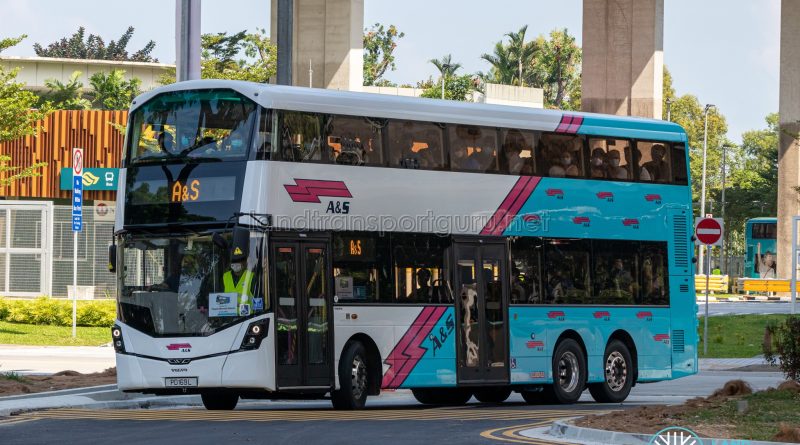
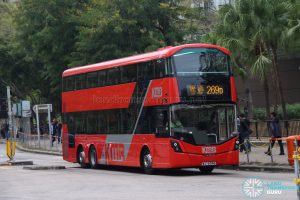
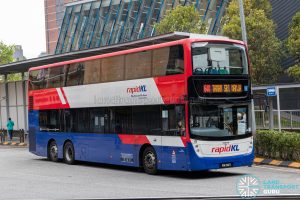

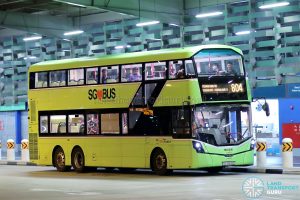
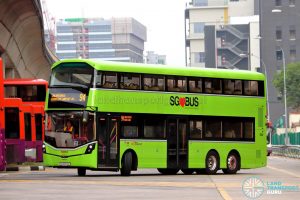

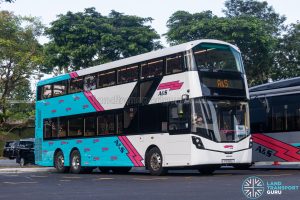

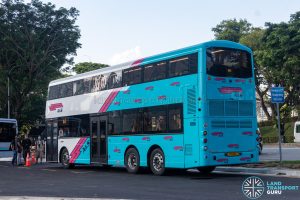
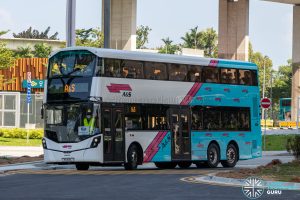
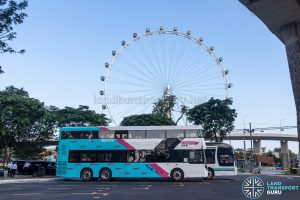
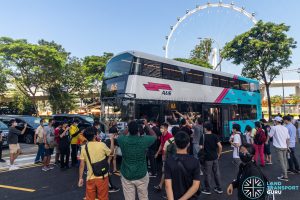
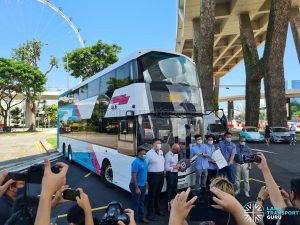

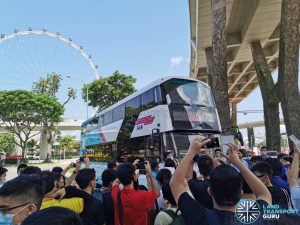
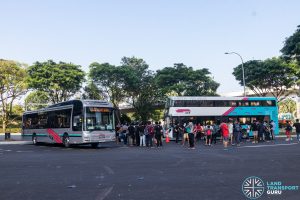
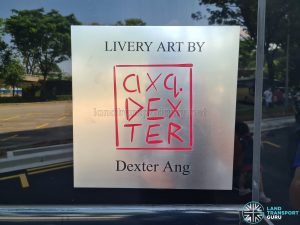

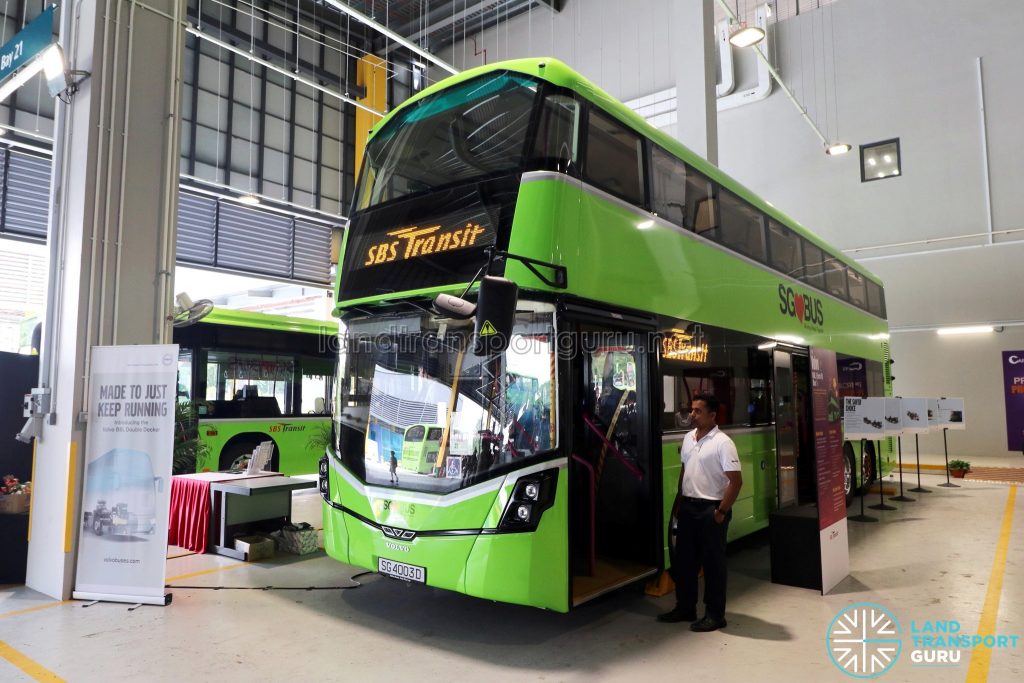

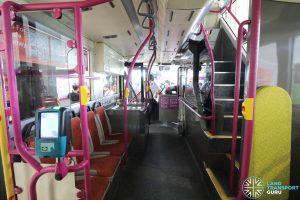
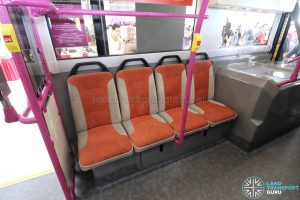
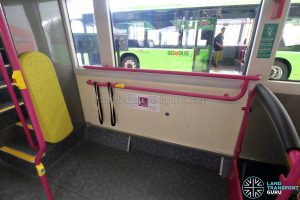
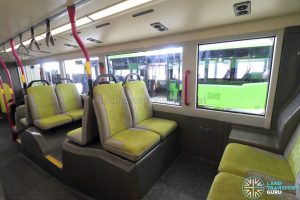



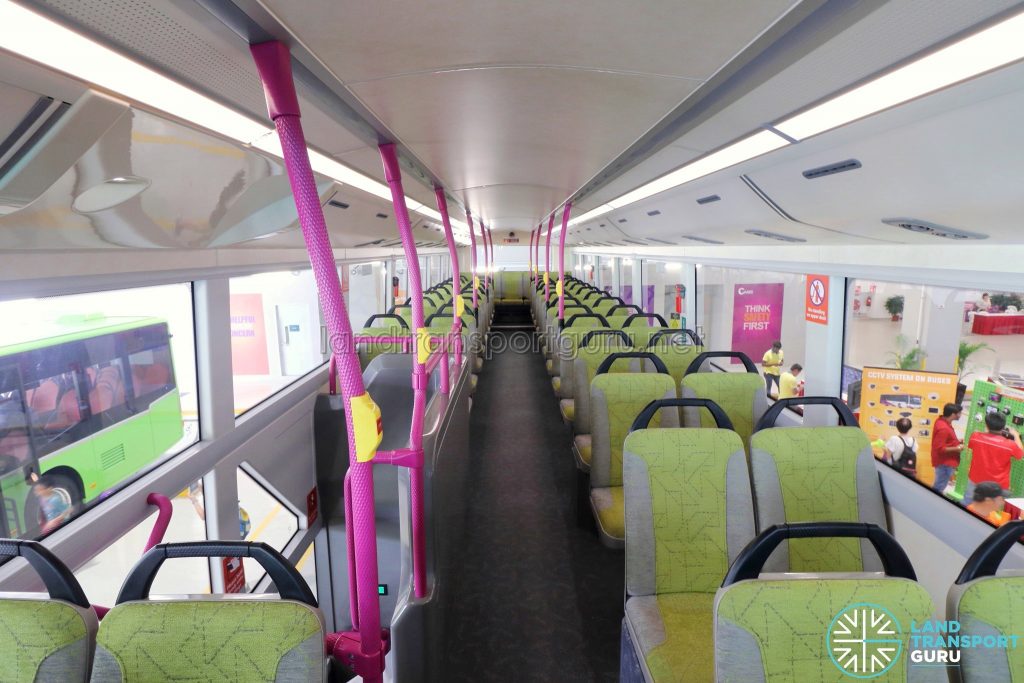

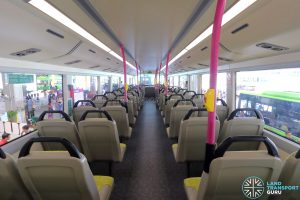

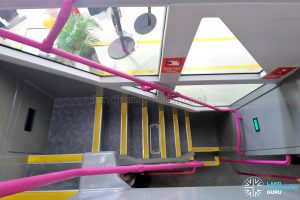


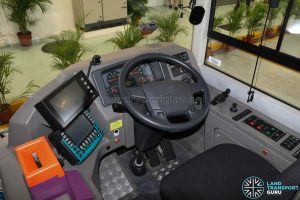

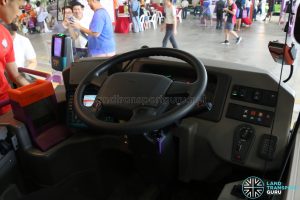
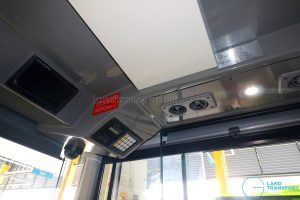
SGWiki now lists the bus as non-revenue, status currently unknown
The bus hasn’t been sighted on the roads since March/April 2020
Ok I wonder why the Volvo B8L is on 851e…. it would be better if it serves on a longer route because its a double decker. And In my opinion the Euro 6 (Referring to both MAN A22 and A95) are better than this.
Any timings for service 71?
Because the ramp was flimsy and there is a sharp bump when dealing the wheelchair ramp, making it difficult to push the wheelchair up, so it got replaced
Why did they even install the automatic ramp when they are gonna replace it with a manuel one?